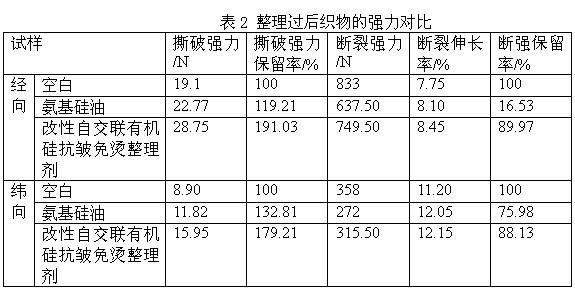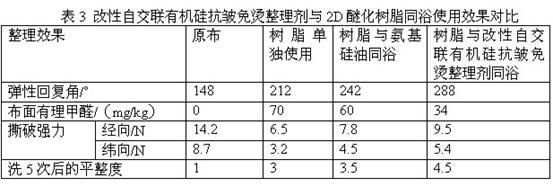Preparation method of non-ironing finishing agent of modified self-crosslinking organosilicon anti-wrinkle microemulsion
A non-iron finishing and self-crosslinking technology, which is applied in fiber treatment, fiber type, textiles and papermaking, etc., can solve the problems of unsatisfactory non-ironing effect, harsh production conditions, and high fabric strength, so as to facilitate large-scale production, Ease of operation and simple experimental methods
- Summary
- Abstract
- Description
- Claims
- Application Information
AI Technical Summary
Problems solved by technology
Method used
Image
Examples
Embodiment 1
[0025] The preparation method of the modified self-crosslinking silicone anti-wrinkle micro-emulsion non-ironing finishing agent in this embodiment includes the preparation process of modified amino silicon crude oil and the preparation process of emulsified finishing agent.
[0026] In the preparation process of modified amino silicone crude oil, the raw materials used include 400kg amino silicone oil, 400kg solvent and 22.2kg epichlorohydrin, wherein isopropanol is used as solvent, and the ammonia value of amino silicone oil is 0.6. The weight ratio of amino silicone oil in the present invention: solvent: epichlorohydrin can be 1: (1-1.5): 0.09252X, where X is the ammonia value of amino silicone oil, and the value of X is usually 0.3-0.9, amino The degree of polymerization of silicone oil is usually 4000-8000, and the solvent in the present invention can be absolute alcohol or isopropanol or isobutanol or glycerol. The equipment used in the preparation process of modified am...
Embodiment 2
[0032] The preparation method of the modified self-crosslinking silicone anti-wrinkle micro-emulsion non-ironing finishing agent in this embodiment includes the preparation process of modified amino silicon crude oil and the preparation process of emulsified finishing agent.
[0033] In the preparation process of the modified amino silicone crude oil, the raw materials used include 400kg amino silicone oil, 400kg solvent and 33.3kg epichlorohydrin, wherein isopropanol is used as the solvent, and the ammonia value of the amino silicone oil is 0.9. The weight ratio of amino silicone oil in the present invention: solvent: epichlorohydrin can be 1: (1-1.5): 0.09252X, where X is the ammonia value of amino silicone oil, and the value of X is usually 0.3-0.9, amino The degree of polymerization of silicone oil is usually 4000-8000, and the solvent in the present invention can be absolute alcohol or isopropanol or isobutanol or glycerol. The equipment used in the preparation process of...
Embodiment 3
[0039] The preparation method of the modified self-crosslinking silicone anti-wrinkle micro-emulsion non-ironing finishing agent in this embodiment includes the preparation process of modified amino silicon crude oil and the preparation process of emulsified finishing agent.
[0040] Wherein the raw material in the modified amino silicon crude oil preparation process comprises amino silicone oil, solvent and epichlorohydrin, this amino silicone oil: solvent: the weight ratio of epichlorohydrin is 1: 1:0.09252X, and wherein X is the ammonia of amino silicone oil value, the value of X is 0.3, the solvent is absolute alcohol or isopropanol or isobutanol or glycerol, and the degree of polymerization of amino silicone oil is 4000-8000. First, mix the amino silicone oil and the solvent evenly, and then slowly drop epichlorohydrin into the mixture of amino silicone oil and solvent through the elevated tank. The dripping time of the epichlorohydrin is 0.5-3 hours, preferably 0.5 hours....
PUM
| Property | Measurement | Unit |
|---|---|---|
| degree of polymerization | aaaaa | aaaaa |
Abstract
Description
Claims
Application Information
 Login to View More
Login to View More - R&D
- Intellectual Property
- Life Sciences
- Materials
- Tech Scout
- Unparalleled Data Quality
- Higher Quality Content
- 60% Fewer Hallucinations
Browse by: Latest US Patents, China's latest patents, Technical Efficacy Thesaurus, Application Domain, Technology Topic, Popular Technical Reports.
© 2025 PatSnap. All rights reserved.Legal|Privacy policy|Modern Slavery Act Transparency Statement|Sitemap|About US| Contact US: help@patsnap.com



